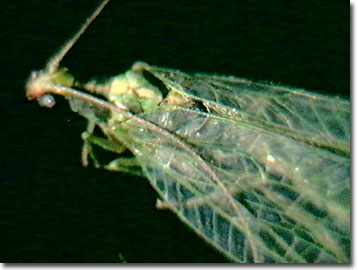Reflected Light Digital Image Gallery
Common Green Lacewing (Chrysoperla rufilabris)
The beautiful and delicate common green lacewings, Chrysoperla rufilabris, feed on nectar, honeydew, and pollen as do butterflies, but their predaceous offspring help control many garden and crop pests. Members of the insect order Neuroptera, lacewings undergo egg, larval, pupal, and adult life stages.

Although not as appreciated as ladybugs, green lacewing larvae, also known as aphid lions, feed voraciously on the eggs and young of aphids, whiteflies, leafminers, some caterpillars, thrips, mealybugs, mites, and are even cannibalistic, when prey insects are in short supply. The aphid lion possesses sickle-shaped jaws that can inject a paralyzing venom, after which the insect is able to suck out the body fluids of its prey. As with the ladybug, eggs and cocoons of lacewings are available commercially for integrated pest management that is not reliant on toxic and expensive insecticides. Each larva can devour 200 or more pest eggs, larvae, or adults per week for its two to three week development period. After spending five days in a spun-silk cocoon, the adult lacewings emerge and mate. Depending on the temperature and other weather conditions, the adult lacewing will live for an additional four to six weeks.
In order to stimulate reproduction, adults need sufficient quantity of high quality nectar, pollen, and honeydew. If these are not available, the adults disperse to more suitable locations, or otherwise, die without reproducing. Artificial stimulation of lacewing reproduction in crop fields is achieved by spraying a mixture of water, sugar, and an artificial powdered dietary product called wheast. Although they cannot handle very cold winters, adult lacewings can overwinter in protected microhabitats. Effective densities of lacewings for pest management are dependent on the level of pest infestation but general recommendations are for 5,000 larvae per acre of cropland or from 5 to 10 lacewing eggs per plant in a garden.
Lacewings are often found in grass, weeds, and on the foliage of trees and shrubs. Their golden eyes contrast well with the brilliant green coloration. The wings of this relatively slow-flying, nocturnal neuropteran are large, veined, and gauze-like and may reach up to 0.3 inch long. Unusual in the insect world, the individual eggs are laid on the end of a tiny stalk, often hanging down from a plant twig or stem. Species of lacewings are found throughout the temperate regions of the Northern Hemisphere. If an adult is captured and handled, a foul fluid is emitted from special glands as a defense mechanism.
Contributing Authors
Cynthia D. Kelly, Thomas J. Fellers and Michael W. Davidson - National High Magnetic Field Laboratory, 1800 East Paul Dirac Dr., The Florida State University, Tallahassee, Florida, 32310.
BACK TO THE REFLECTED LIGHT IMAGE GALLERY
BACK TO THE DIGITAL IMAGE GALLERIES
Questions or comments? Send us an email.
© 1995-2025 by Michael W. Davidson and The Florida State University. All Rights Reserved. No images, graphics, software, scripts, or applets may be reproduced or used in any manner without permission from the copyright holders. Use of this website means you agree to all of the Legal Terms and Conditions set forth by the owners.
This website is maintained by our
Graphics & Web Programming Team
in collaboration with Optical Microscopy at the
National High Magnetic Field Laboratory.
Last Modification Friday, Nov 13, 2015 at 01:19 PM
Access Count Since September 17, 2002: 12568
Visit the website of our partner in introductory microscopy education:
|
|
